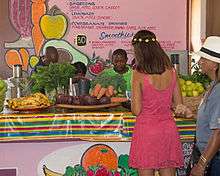Smoothie
.jpg)
A smoothie (occasionally spelled smoothee or smoothy) is a thick, cold beverage made from pureed raw fruit, and sometimes vegetables, typically using a blender. Smoothies are often blended with other ingredients such as water, crushed ice, fruit juice, sweeteners (e.g. honey, sugar, stevia, syrup), dairy products (e.g. milk, yogurt, or cottage cheese, whey powder), plant milk, nuts, nut butter, seeds, tea, chocolate, herbal supplements, or nutritional supplements. A smoothie containing dairy products is similar to a milkshake, though the latter typically contains less fruit and often contains ice cream or frozen yogurt.
Health
The healthfulness of a smoothie depends on its ingredients and their proportions. Many smoothies include large or multiple servings of fruits and vegetables, which are recommended in a healthy diet. However, too many sweet fruits and/or too much fruit juice can lead to too much sugar.[1] Similarly, ingredients such as protein powders, sweeteners, or ice cream are often used in smoothie recipes, some of which are not necessarily healthful.
Smoothies include dietary fiber (e.g. pulp, often also skin and seeds) and so are thicker than fruit juice, often with a consistency similar to a milkshake, but it can be thinner. The fiber is what makes smoothies more healthful than fruit juice, which recently has been implicated to be as unhealthful as soda pop in some cases.[2] Smoothies—particularly "green smoothies" that include vegetables (see below)—are often marketed to health-conscious people, for example, being a healthier alternative to milkshakes.
Green smoothie
.jpg)
A "green smoothie" typically consists of 40–50%[3][4][5] green vegetables—usually raw green leafy vegetables such as spinach, kale, swiss chard, collard greens, celery, parsley, or broccoli—with the remaining ingredients being mostly or entirely fruit.[6] Some commercial green smoothies may contain a smaller percentage of green vegetables.[7] Most green leafy vegetables have a bitter flavor when served raw, but this can be ameliorated by choosing certain less-bitter or younger vegetables (e.g. baby spinach is almost flavourless) or combining with certain fruit (e.g. banana softens both the flavour and texture).
Green smoothies have grown rapidly in popular culture since the early 2000s.[8] Some blender manufacturers now specifically target their products towards making green smoothies and provide a booklet of recipes for them.[9]
Around the world
Smoothies have become increasingly popular worldwide since the 1990s,[10] due in part to having some smoothies that are factory-produced (usually in bottles), enabling them to be sold via supermarkets and other mass-market outlets. However, some types of smoothie have a much longer history in certain countries.
United States
Health food stores on the West Coast of the United States began selling smoothies in the 1930s thanks to the invention of the electric blender.[11] The actual term "smoothie" was being used in recipes and trademarks by the mid-1930s.
By the late 1960s, smoothies were widely sold across the US by ice cream vendors as well as health food stores. They were mainly made from fruit, fruit juice, and ice, though from the early 1970s, ice milk was sometimes added to create the "fruit shake".
In 1973, Steve Kuhnau founded Smoothie King. He set up numerous smoothie bars across the United States and popularized adding ingredients and dietary supplements such as vitamins and protein powder into the smoothies. As smoothies became more popular, larger companies decided to make bottled smoothies and sell them in supermarkets.
Bangladesh
Borhani is a type of spicy yogurt smoothie made in Bangladesh. Borhani is made with spices like ginger powder, black salt, green chilies, and ground black pepper, as well as the leaves of herbs such as mint or coriander. Bangladeshis generally drink Borhani after eating lunch and dinner, and the drink is sometimes served at weddings or important ceremonies.

Other countries
Many different smoothies are part of Indian, Mediterranean, and Middle Eastern cuisine. Fruit sharbat (a popular West and South Asian drink) typically includes yogurt and honey. In India, the lassi is a smoothie or milkshake comprising crushed ice, yogurt, sometimes sugar, and often mango; in the south, pineapple smoothies made with crushed ice, sugar and no yogurt are more popular.
Smoothies are also sometimes mixed with soft drinks, or mixed with alcohol to make cocktails.
See also
References
- ↑ Boseley, Sarah (2013-09-07). "Smoothies and fruit juices are a new risk to health, US scientists warn". The Guardian. ISSN 0261-3077. Retrieved 2016-03-27.
- ↑ Choices, NHS. "5 A DAY FAQs - Live Well - NHS Choices". www.nhs.uk. Retrieved 2016-03-27.
- ↑ Boutenko, Victoria "Ode to a Green Smoothie", first published 2005 newsletter, RawFamily.com. Reprinted in Kyssa, Natasha (2009). The SimplyRaw Living Foods Detox Manual, beginning p.29. ISBN 1-55152-250-0.
- ↑ Zavasta, Tonya (2009), "Smooth Moves: Enjoy the Benefit of Green Smoothies and Puddings", Raw Food and Hot Yoga, p. 39, ISBN 0-9742434-9-3,
A green smoothie...is a mixture of about 60 percent fruit and 40 percent leafy greens blended together in a delicious, nourishing beverage.
- ↑ Smith Jones, Susan (2008). Health Bliss, p.179. ISBN 1-4019-1241-9. "...about 50-60 percent fruit and 40-50 percent greens."
- ↑ Caldwell, Kim (2009) How Green Smoothies Saved My Life: A Guide for Using Green Smoothies, Uplifted Thinking, and Live Food to Enhance Your Life, p.12. ISBN 0-615-30290-4.
- ↑ "Naked Juice Green Machine". www.nakedjuice.com. Retrieved 2018-08-20.
- ↑ "Google Ngram Viewer". Google Books. Retrieved 2016-03-27.
- ↑ (Nov 2008 - Jan 2009). Organic Gardening, p.44. Vol. 56, No. 1. ISSN 1536-108X.
- ↑ "Google Ngram Viewer". books.google.com. Retrieved 2016-03-27.
- ↑ Brown, Ellen (2005). The Complete Idiot's Guide to Smoothies. p. 3. ISBN 1-59257-318-5.
Further reading
- O'Brian, Betty Sue (2009). Going Green the Smoothie Way. ISBN 0-578-02306-7.
- Smith, JJ (2014). 10-Day Green Smoothie Cleanse. Atria Books. ISBN 978-1501100109.
External links
| Wikimedia Commons has media related to Smoothies. |
